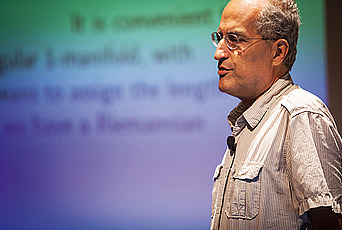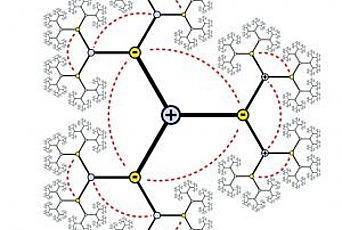Modern Mathematics and the Langlands Program

It has been said that the goals of modern mathematics are reconstruction and development.1 The unifying conjectures between number theory and representation theory that Robert Langlands, Professor Emeritus in the School of Mathematics, articulated in a letter to André Weil in 1967, continue a tradition at the Institute of advancing mathematical knowledge through the identification of problems central to the understanding of active areas or likely to become central in the future.
“Two striking qualities of mathematical concepts regarded as central are that they are simultaneously pregnant with possibilities for their own development and, so far as we can judge from a history of two and a half millennia, of permanent validity,” says Langlands. “In comparison with biology, above all with the theory of evolution, a fusion of biology and history, or with physics and its two enigmas, quantum theory and relativity theory, mathematics contributes only modestly to the intellectual architecture of mankind, but its central contributions have been lasting, one does not supersede another, it enlarges it.”2
In his conjectures, now collectively known as the Langlands program, Langlands drew on the work of Harish-Chandra, Atle Selberg, Goro Shimura, André Weil, and Hermann Weyl, among others with extensive ties to the Institute.
Weyl, whose appointment to the Institute’s Faculty in 1933 followed those of Albert Einstein and Oswald Veblen, was a strong believer in the overall unity of mathematics, across disciplines and generations. Weyl had a major impact on the progress of the entire field of mathematics, as well as physics, where he was equally comfortable. His work spanned topology, differential geometry, Lie groups, representation theory, harmonic analysis, and analytic number theory, and extended into physics, including relativity, electromagnetism, and quantum mechanics. “For [Weyl] the best of the past was not forgotten,” notes Michael Atiyah, a former Institute Professor and Member, “but was subsumed and refined by the mathematics of the present.”3
Geometry and analysis were central to Weyl’s interests, and his inclination to organize and synthesize drew him to the theory of groups and their representations, also known as symmetry. Weyl brought representation theory into quantum mechanics, leading the way for modern physicists to think of unexpected regularities in terms of underlying symmetry groups.
With much help from Weyl, Lie groups and Lie algebras became central to mathematics and theoretical physics. Under the combined influences of relativity theory and quantum mechanics, the study of infinite-dimensional representations of Lie groups was transformed into a major field in contemporary mathematics by Harish-Chandra. Harish-Chandra first came to the Institute in 1947–48 as an assistant to the theoretical physicist Paul Dirac, who wrote one of the first papers on infinite dimensional irreducible representations. Harish-Chandra ultimately abandoned physics to study representation theory and harmonic analysis of semisimple Lie groups.
Langlands’s early work in representation theory involved adapting the methods of Harish-Chandra to the theory of automorphic forms. Endoscopy, which aims to distinguish the internal structure of automorphic representations of different groups, arose from Langlands’s study of the zeta functions of Shimura varieties developed by Goro Shimura and in the theory of the discrete series, a theory created by Harish-Chandra at the Institute in the sixties. The modern theory of Shimura varieties, so named by Langlands in the 1970s, began with the development of the theory of abelian varieties with complex multiplication by Shimura, Yutaka Taniyama, and Weil in the mid-1950s.
Langlands’s principle of functoriality, which uses the Selberg trace formula and the fundamental lemma to link automorphic representations of different groups through their L-groups, was informed by the theory of class fields, and the representation theory of semisimple Lie groups in the form given to it by Harish-Chandra.
Much of the modern theory of automorphic forms is governed by two fundamental problems that are at the heart of the Langlands program: Langlands’s principle of functoriality and the general analogue of the Shimura-Taniyama-Weil conjecture on modular elliptic curves. The work of Andrew Wiles that led to a proof of Fermat’s Last Theorem suggests that the two problems, among the deepest questions in mathematics, are inextricably linked.4
“Weyl was the father of the theory of representations of Lie groups, and Harish-Chandra was one of the great champions of the subject before Langlands came along,” says Peter Sarnak, Professor in the School of Mathematics. “The theory of representations comes up in physics. It comes up in algebra. Langlands’s insight was its role in number theory.”
The breadth and scope of Langlands’s mathematical vision, from the trace formula, functoriality, and endoscopy to representation theory and Shimura varieties, can be explored through his papers and some of his correspondence and lectures, which are posted at http://publications.ias.edu/rpl/. The materials provide a sense of the historical context, precedents, and explorations that led to the recent proof of the fundamental lemma. They also articulate Langlands’s view of the problems still in need of attention and suggest directions for unifying distant concepts and finding new connections between apparently unrelated subjects.
The Unity of Mathematics
Mathematics is part of the general scientific culture. We are contributing to a whole, organic collection of ideas, even if the part of mathematics which I’m doing now is not of direct relevance and usefulness to other people. If mathematics is an integrated body of thought, and every part is potentially useful to every other part, then we are all contributing to a common objective. If mathematics is to be thought of as fragmented specializations, all going off independently and justifying themselves, then it is very hard to argue why people should be paid to do this. We are not entertainers, like tennis players. The only justification is that it is a real contribution to human thought. Even if I’m not directly working in applied mathematics, I feel that I’m contributing to the sort of mathematics that can and will be useful for people who are interested in applying mathematics to other things.—Michael Atiyah
Modern mathematics has become so extensive and so complex that it is essential, if mathematics is to stay as a whole and not become a pile of little bits of research, to provide a unification, which absorbs in some simple and general theories all the common substrata of the diverse branches of the science, suppressing what is not so useful and necessary, and leaving intact what is truly the specific detail of each big problem. . . . Very few persons are capable of grasping the entire forefront of science, of seizing not only the weak points of resistance, but also the part that is most important to take on, the art of massing the troops, of making each sector work toward the success of the others, etc. ––André Weil
We are not very pleased when we are forced to accept a mathematical truth by virtue of a complicated chain of formal conclusions and computations, which we traverse blindly, link by link, feeling our way by touch. We want first an overview of the aim and of the road; we want to understand the idea of the proof, the deeper context. . . . A modern mathematical proof is not very different from a modern machine, or a modern test setup: the simple fundamental principles are hidden and almost invisible under a mass of technical details.—Hermann Weyl
1 “On A. Weil,” by Yutaka Taniyama, Bulletin of the American Mathematical Society 46, no. 4 (October 2009), 667–68
2 “Is There Beauty in Mathematical Theories?” lecture delivered by Robert P. Langlands, University of Notre Dame, January 2010, http://publications.ias.edu/rpl_works/L12/beauty/ND.pdf
3 “Hermann Weyl, November 9, 1885–December 9, 1955,” by Michael Atiyah, Biographical Memoirs 82, (National Academies Press, 2003), www.nap.edu/readingroom.php?book=biomems&page=hweyl.html
4 Preface by James Arthur, David Ellwood, Robert Kottwitz in Harmonic Analysis, the Trace Formula, and Shimura Varieties, Clay Mathematics Proceedings 4 (2005), 265–66, www.claymath.org/library/proceedings/cmip04.pdf


